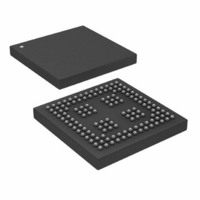ADSP-21261SKBC-150 Analog Devices Inc, ADSP-21261SKBC-150 Datasheet - Page 4

ADSP-21261SKBC-150
Manufacturer Part Number
ADSP-21261SKBC-150
Description
150 MHz, 32Bit DSP Processor.
Manufacturer
Analog Devices Inc
Series
SHARC®r
Type
Fixed/Floating Pointr
Datasheet
1.ADSP-21261SKBCZ150.pdf
(44 pages)
Specifications of ADSP-21261SKBC-150
Interface
DAI, SPI
Clock Rate
150MHz
Non-volatile Memory
ROM (384 kB)
On-chip Ram
128kB
Voltage - I/o
3.30V
Voltage - Core
1.20V
Operating Temperature
0°C ~ 70°C
Mounting Type
Surface Mount
Package / Case
136-CSPBGA
Lead Free Status / RoHS Status
Contains lead / RoHS non-compliant
Available stocks
Company
Part Number
Manufacturer
Quantity
Price
Company:
Part Number:
ADSP-21261SKBC-150
Manufacturer:
AD
Quantity:
30
ADSP-21261
GENERAL DESCRIPTION
The ADSP-21261 SHARC DSP is a member of the SIMD
SHARC family of DSPs featuring Analog Devices Super Har-
vard Architecture. The ADSP-21261 is source code compatible
with the ADSP-2126x, ADSP-21160, and ADSP-21161 DSPs, as
well as with first generation ADSP-2106x SHARC processors in
SISD (single-instruction, single-data) mode. Like other SHARC
DSPs, the ADSP-21261 is a 32-bit/40-bit floating-point proces-
sor optimized for high performance signal processing applica-
tions with its dual-ported on-chip SRAM, mask-programmable
ROM, multiple internal buses to eliminate I/O bottlenecks, and
an innovative digital applications interface.
As shown in the Functional Block Diagram on Page 1, the
ADSP-21261 uses two computational units to deliver a five to 10
times performance increase over previous SHARC processors
on a range of DSP algorithms. Fabricated in a state-of-the-art,
high speed, CMOS process, the ADSP-21261 DSP achieves an
instruction cycle time of 6.67 ns at 150 MHz. With its SIMD
computational hardware, the ADSP-21261 can perform
900 MFLOPS running at 150 MHz.
Table 1. ADSP-21261 Benchmarks (at 150 MHz)
1
The ADSP-21261 continues SHARC’s industry-leading stan-
dards of integration for DSPs, combining a high performance
32-bit DSP core with integrated, on-chip system features.
The block diagram of the ADSP-21261
following architectural features:
Table 1
Benchmark Algorithm
1024 Point Complex FFT (Radix 4, with reversal) 46 μs
FIR Filter (per tap)
IIR Filter (per biquad)
Matrix Multiply (pipelined)
[3×3] × [3×1]
[4×4] × [4×1]
Divide (y/×)
Inverse Square Root
Assumes two files in multichannel SIMD mode.
• Two processing elements, each containing an ALU, multi-
• Data address generators (DAG1, DAG2)
• Program sequencer with instruction cache
• PM and DM buses capable of supporting four 32-bit data
• Three programmable interval timers with PWM genera-
• On-chip dual-ported SRAM (1M bit)
plier, shifter, and data register file
transfers between memory and the core at every core pro-
cessor cycle
tion, PWM capture/pulse width measurement, and
external event counter capabilities
shows performance benchmarks for the ADSP-21261.
1
1
on Page 1
Speed
(at 150 MHz)
2.5 ns
10 ns
22.5 ns
40 ns
15 ns
22.5 ns
illustrates the
Rev. 0 | Page 4 of 44 | March 2006
Figure 2
precision clock generator to interface with an I
I
would generate itself. Many other SRU configurations are
possible.
ADSP-21261 FAMILY CORE ARCHITECTURE
The ADSP-21261 is code compatible at the assembly level with
the ADSP-2126x, ADSP-2136x, ADSP-2116x, and the first gen-
eration ADSP-2106x SHARC DSPs. The ADSP-21261 shares
architectural features with the ADSP-2126x, ADSP-2136x, and
ADSP-2116x SIMD SHARC family of DSPs, as detailed in the
following sections.
SIMD Computational Engine
The ADSP-21261 contains two computational processing ele-
ments that operate as a single-instruction, multiple-data
(SIMD) engine. The processing elements are referred to as PEX
and PEY and each contains an ALU, multiplier, shifter, and reg-
ister file. PEX is always active, and PEY may be enabled by
setting the PEYEN mode bit in the MODE1 register. When this
mode is enabled, the same instruction is executed in both pro-
cessing elements, but each processing element operates on
different data. This architecture is efficient at executing math
intensive DSP algorithms.
Entering SIMD mode also has an effect on the way data is trans-
ferred between memory and the processing elements. When in
SIMD mode, twice the data bandwidth is required to sustain
computational operation in the processing elements. Because of
this requirement, entering SIMD mode also doubles the band-
width between memory and the processing elements. When
using the DAGs to transfer data in SIMD mode, two data values
are transferred with each access of memory or the register file.
Independent, Parallel Computation Units
Within each processing element is a set of computational units.
The computational units consist of an arithmetic/logic unit
(ALU), multiplier, and shifter. These units perform all opera-
tions in a single cycle. The three units within each processing
2
S DAC with a much lower jitter clock than the serial port
• On-chip dual-ported, mask-programmable ROM
• JTAG test access port
• 8- or 16-bit parallel port that supports interfaces to off-chip
• DMA controller
• Four full-duplex serial ports
• SPI-compatible interface
• Digital applications interface that includes two precision
(3M bit)
memory peripherals
clock generators (PCG), an input data port (IDP), four
serial ports, eight serial interfaces, a 20-bit synchronous
parallel input port, 10 interrupts, six flag outputs, six flag
inputs, three programmable timers, and a flexible signal
routing unit (SRU)
shows one sample configuration of a SPORT using the
2
S ADC and an













